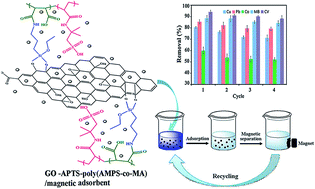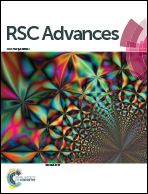Adsorptive removal of toxic metals and cationic dyes by magnetic adsorbent based on functionalized graphene oxide from water
Abstract
In this study, a new magnetic nanocomposite adsorbent was prepared from amino-silane functionalized graphene oxide (GO-APTS) and a copolymer of 2-acrylamido-2-methylpropanesulfonic acid (AMPS)/maleic anhydride (MA) [poly(AMPS-co-MA)], and adsorptive removal of Pb(II), Cu(II) and Co(II) and cationic dyes such as crystal violet (CV) and methylene blue (MB) from water was investigated. The magnetic adsorbent GO-APTS-poly(AMPS-co-MA)/Fe3O4 was characterized by the Fourier transform infrared spectroscopy (FT-IR), field emission scanning electron microscopy (FE-SEM), energy dispersive X-ray spectroscopy (EDS), X-ray diffraction (XRD), vibrating sample magnetometer (VSM), and thermogravimetric analysis (TGA). The effect of different factors on adsorption efficiency such as pH, adsorbent dosage, contact time, the concentration of adsorbates and temperature were investigated. The adsorption results fitted well with the Langmuir isotherm and pseudo-second-order kinetic model. The maximum adsorption capacity (Qm) was 310.10, 282.25, 238.35, 416.06 and 440.97 mg g−1 for Pb(II), Cu(II), Co(II), MB and CV, respectively. The adsorption was proposed to be chemisorption, spontaneous, and endothermic. The adsorbent was regenerated by several adsorptions/desorption processes. The prepared adsorbent can be highly efficient, magnetically separable and reusable for water purification.


 Please wait while we load your content...
Please wait while we load your content...